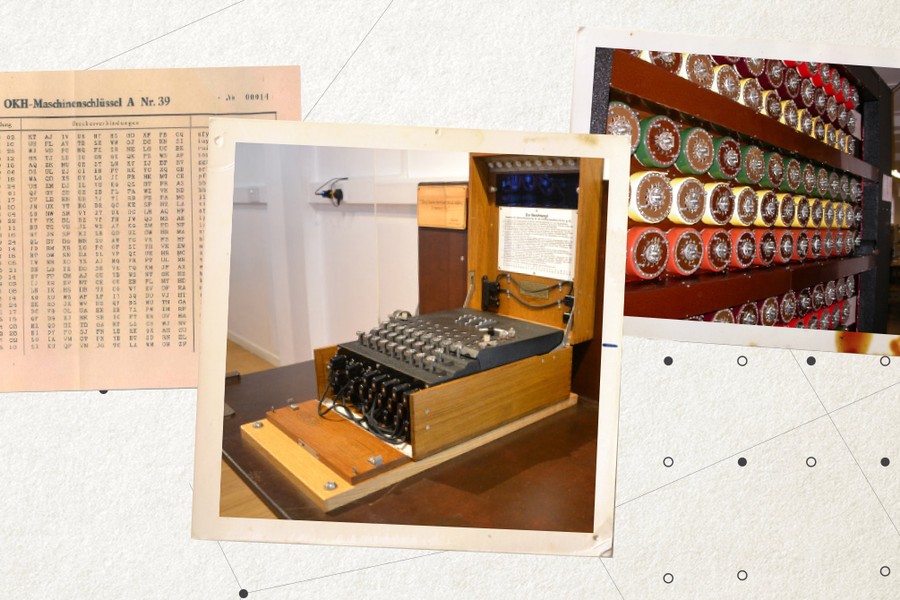To encrypt a message, the sender's Enigma was set to the key of the day (changing at midnight) and the three scrambling wheels were set to a different start position for each message (sent as the message header). As each plain-text letter was typed, a lamp would light to show the corresponding encrypted letter, and the right-hand wheel would advance to change the scrambling of the next letter.
To decrypt a message, the multiple recipients would use the message header and the known key of the day to set their Enigma and its wheels to exactly match the sending Enigma. As the encrypted text was then typed, the original plain text would be read from the lamps.
The settings comprising the key of the day consisted of:
- Walzenlage: the choice and order of three scrambling wheels from a set of five (later eight for the Naval Enigma).
- Ringstellung: a setting for a ring on each wheel defining the point at which that wheel moved on as letters were typed, to give 26x26x26 changes.
- Steckerverbindungen: the positions of ten scrambling links between the keys, the scrambling wheels, and then the lamps.
- This gives at least 150,000,000,000,000,000,000 combinations; a number on which no two analysts agree...
The attack:
It was the Poles who, knowing in the 1930's that they were under threat, set up a successful department to break the Enigma traffic they were intercepting at that time. However, they recognised that their technique would fail when the Germans would add extra wheels and change their procedures for wartime use. They passed all their knowledge to Bletchley Park, where Alan Turing and a brilliant team invented, constructed and used the legendary Turing/Welchman Bombe of which over 200 were eventually manufactured.
A completely authentic and fully operational Bombe has been built by a team of volunteers, and is demonstrated daily at The National Museum of Computing at Bletchley Park. We regularly break keys sent as Challenges by GCHQ.
Turing's brilliant strategy was based on cribs ('guessed plaintext' in modern parlance), thereby overcoming enough of the Poles' problems, and when Gordon Welchman added the Diagonal Board the throughput increased to typically break the key of the day within a few hours of the daily change.
Lessons for today:
Immeasurably high combinations do not guarantee security.
However high the number of possible combinations, the crib approach implemented by the Bombe completely sidestepped all of the combination calculations, and the Bombe even used the Steckerverbindungen, as part of the solution rather than part of the problem.
Single key, multiple users.
Because it was - and often still is - necessary that many users in a group should all be able to read each other's messages, as long as a crib could be found from any one user, then the broken key would allow Bletchley Park to read everyone's messages for the rest of that day.
Any single careless operator could compromise the whole network.
Cribs.
There really are a lot more cribs around today than there were then.
For example, once you know who sent an intercepted email, you probably have a perfect crib: how often do you change the automated signature at the end of all your messages?
Systematic errors.
If you look again at the OKH-Maschinenschlüssel you will see a classic example of 'good engineering, very bad cryptography'.
Consider: if the original choice of five wheels gives 60 wheel orders, what is the reduced wheel order choice on any given day as a result of the blunder encapsulated in this monthly chart?
Hint: the engineers felt it was a good idea not to leave the wheels in the same place day after day, so as to keep the contacts in good order.
Backwards-compatible system-wide updates.
Admiral Doenitz was perhaps the most suspicious of them all about the security of the Enigma. He increased the set of wheels to eight, and introduced a four-wheel Enigma for the U-boat fleet, but some identical messages were sent in both 3- and 4- wheel form.
At this point, of course, the scrambling of the new wheels was revealed.
Codebreakers, like burglars, do not leave footprints.
Long before the Zimmerman Telegram in 1917, we well understood the need for the enemy (and some friends) to believe that their communications were secure. If they wanted to believe that it was just bad luck that a spotter plane had happened to come across a convoy in the Mediterranean which was subsequently attacked, then it was not up to us to disabuse them. Indeed, on one (admittedly possibly apocryphal) occasion when it was too foggy to fly, a message was sent to an imaginary agent in Naples thanking him for pointing us at a recently attacked North African convoy.
They wanted to believe.
Conclusions
It's the people, not the machines.
These mistakes are all available today.
Our people have to be cleverer than theirs.
Paul Kellar
Paul Kellar, MBE, retired after an engineering career as Director of Research of Quantel. He is now Chair of the Turing/Welchman Bombe Rebuild Trust, which owns and operates the Bombe at The National Museum of Computing at Bletchley Park. Paul is a long-term private client of JM Finn.
About The National Museum of Computing
The National Museum of Computing at Bletchley Park brings to life the history and ongoing development of computing with the world’s largest collection of historic working computers. Catering for generalist and specialist audiences, the museum is regarded as one of the world’s top computing museums. Funded solely by entrance fees and private donations, the Museum welcomes support in its work.
©2019 The Turing Welchman Bombe Rebuild Trust




